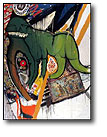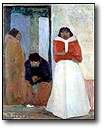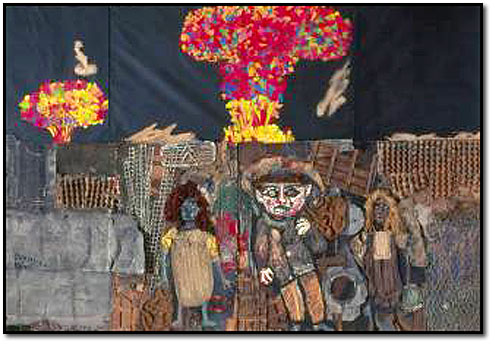Museum of Fine Arts, Houston,
Jun 20, 2004 - Sep 12, 2004
Houston, TX, USA
Inverted Utopias
by Annie Laurie Sánchez
While the titles of the constellations have been criticized for perhaps being trite or cute, the wall text that follows each on its designated marquis effectively explains the reason for the title. The cuteness is helpful for remembering what one is looking for when relating the works in each space. The constellations are titled: "Play and Grief," "Progression and Rupture," "Cryptic and Committed," "Geometric and Concrete," "Universal and Vernacular," "Touch and Gaze," and "Vibrational and Stationary" (listed in the order in which this reviewer saw them there is, however, no particular or recommended order a visitor need follow). The MFAH’s marquis stands and wall text do an excellent job of explaining each grouping in an interesting and cohesive way. (All of these texts are in English and Spanish, as is the audio tour.) The main marquis, for example, explains the time frame of the exhibition and that the exhibition is not intended as a survey or full history of the specified decades, but select highlights with works that are examples of art "paving the way to utopian societies" - those that advocate reform. The very title comes from this concept, and from a previous exhibition based on similar principles, which this exhibition follows in many ways: Heterotopias: medio siglo sin-lugar, Madrid, 2000, also organized by Ramírez and Olea. In Inverted Utopias, they go a step further to examine the concepts of these works beyond the notion of different utopias, to that of utopias altogether inverted by circumstance, economics, social inequities, and politics, or utopias whose fundamental aspects surprise or invert what might normally be expected.
A single review is not enough to cover each constellation one by one, but suffice to summarize their goals, and to state that they are replete with some of the most remarkable artworks of anytime and any country. Before entry into the Caroline Weiss Law building of the MFAH, Jesus Soto’s Pentrable Amarillo, 1973, greets visitors as they approach the entrance doors. This work might belong to "Touch and Gaze," as it requires visitors to interact with it; one enters the construction (yellow nylon tubes suspended from some 10 feet above) and immediately senses things differently: the world beyond is colored and fragmented by the forest of tubes, and every movement causes all of the tubes to move in different ways. When two people or more are among the tubes, the can feel each other’s every movement. This work is an excellent introduction to what the exhibition will be, and made even more meaningful as a conclusion as the visitor exits through the same doors.
Up the short staircase past the main desk and the main marquis that explains the exhibition is "Play and Grief," made intriguing and shocking by the space’s red walls. As the marquis tells viewers, this section is marked by the artists’ uses of satire, parody or irony to "probe the dark side of the human condition." León Ferrari, Luis Felipe Noé, José Clemente Orozco and Anontio Berni are but a few of the featured artists in this space. In addition, the museum created a special interactive display of the artist books of Techo de la Ballena. Here visitors can use a computer to browse the pages and illustrations of these rare and beautiful books, and read explanations of them (in English or Spanish). This "special presentation" is also available on the museum’s website, along with a special explanation of the exhibition and some previews of different areas, designated by bodily senses.
|









